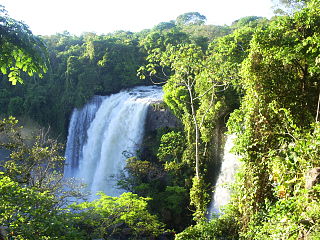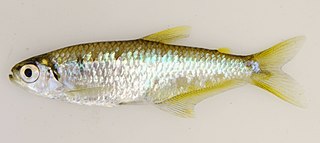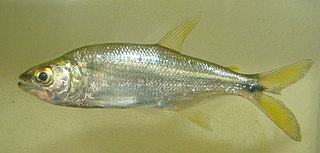
Characidae, the characids or characins is a family of freshwater subtropical and tropical fish, belonging to the order Characiformes. The name "characins" is the historical one, but scientists today tend to prefer "characids" to reflect their status as a by and large monophyletic group at family rank. To arrive there, this family has undergone much systematic and taxonomic change. Among those fishes that remain in the Characidae for the time being are the tetras, comprising the very similar genera Hemigrammus and Hyphessobrycon, as well as a few related forms such as the cave and neon tetras. Fish of this family are important as food and also include popular aquarium fish species.

Hyphessobrycon is a genus of freshwater fish in the family Characidae. These species are among the fishes known as tetras. The genus is distributed in the Neotropical realm from southern Mexico to Río de la Plata in Argentina. Many of these species are native to South America; about six species are from Central America and a single species, H. compressus is from southern Mexico.

Astyanax is a genus of freshwater fish in the family Characidae of the order Characiformes. Some of these fish, like many of their relatives, are kept as aquarium pets and known collectively as tetras. With around 150 described species and new ones being described yearly, this genus is among the largest of the entire order; Hyphessobrycon also has more than 145 species and which one is larger at any one time depends on whether more species have been recently described in one or the other. The blind and colorless cave tetra of Mexico is a famous member of the genus, but its taxonomic position is disputed: Some recognize it as part of the Mexican tetra and this is supported by phylogenetic evidence, but others recognize the cave form as a separate species, A. jordani.

Cynodontinae is a subfamily of tropical and subtropical South American fishes of the family Cynodontidae. They are characterized by an oblique mouth and very long distinct canines, which are used to capture and stab their prey, other fish that can be up to half the length of the cynodontine itself. They are not prized as food fish, but are important in subsistence and commercial fisheries. Hydrolycus are game fish, having been recently added to the International Game Fish Association in the fly and rod class. Cynodontid fish are also sometimes housed in aquaria.

The Curuá River is a tributary of the Iriri River in Pará state in north-central Brazil. It is a tributary of the Iriri River.

Moenkhausia is a genus of freshwater fish in the family Characidae native to tropical and subtropical South America. These are medium-sized tetras where the largest species only reach around 12 cm (4.7 in).
Axelrodia is a genus of small characin from the Amazon Basin and Meta River in South America, with three currently described species:

Creagrutus is a genus of characins found mostly in South America, with one species C. affinis extending into Panama in Central America.

Diapoma is a genus of characins from tropical South America.

Hemigrammus is a genus of freshwater fish in the family Characidae native to South America and commonly seen in the aquarium trade. These are medium-small tetras where the largest species reach up to around 11 cm (4.3 in).
Knodus is a genus of characins, small freshwater fish from South America.
Monotocheirodon is a genus of characins native to tropical South America. The currently recognized species in this genus are:

Oligosarcus is a genus of characins from freshwater habitats in northern Argentina, Paraguay, Uruguay, eastern Bolivia, and southern and central Brazil. They reach up to 31 cm (12 in) in length and are predators that mainly feed on smaller fish.
Rhinopetitia is a genus of characins endemic to Brazil.

Tetragonopterus is a genus of fish in the family Characidae native to South America.

Pyrrhulina is a genus of freshwater fishes found in tropical South America. Several of these species are popular aquarium fish.
Cyanogaster noctivaga is a species of characin native to the Rio Negro, Brazil. This species is the only known member of the genus Cyanogaster and its scientific name translates as the blue-bellied night wanderer, referring to its unique appearance and nocturnal habits. It was first described in 2013, having been discovered in October 2011 on a scientific expedition organised by the University of São Paulo, Brazil.
Heiko Bleher is a German researcher, author, photographer, and filmmaker. He is best known in the scientific community for his contribution to the exploration of fresh and brackish water habitats worldwide. He has discovered numerous species of fish and aquatic plant, several of which carry his name or are named in honor of Bleher's family.

Iguanodectidae is a family of freshwater fish in the order Characiformes that lives in South America. It is home to the subfamily Iguanodectinae and the monotypic Bryconops clade. Several species in the family, such as the green line lizard tetra, the tailspot tetra, and the orangefin tetra, are sometimes taken as aquarium fish.
Iguanodectes polylepis is a species of freshwater fish from the rivers of South America. Its range is restricted to Brazil, where it inhabits the Madeira and Purus river basins. It is one of the larger members of the genus, but remains generally small, only a little over a quarter-foot long.












